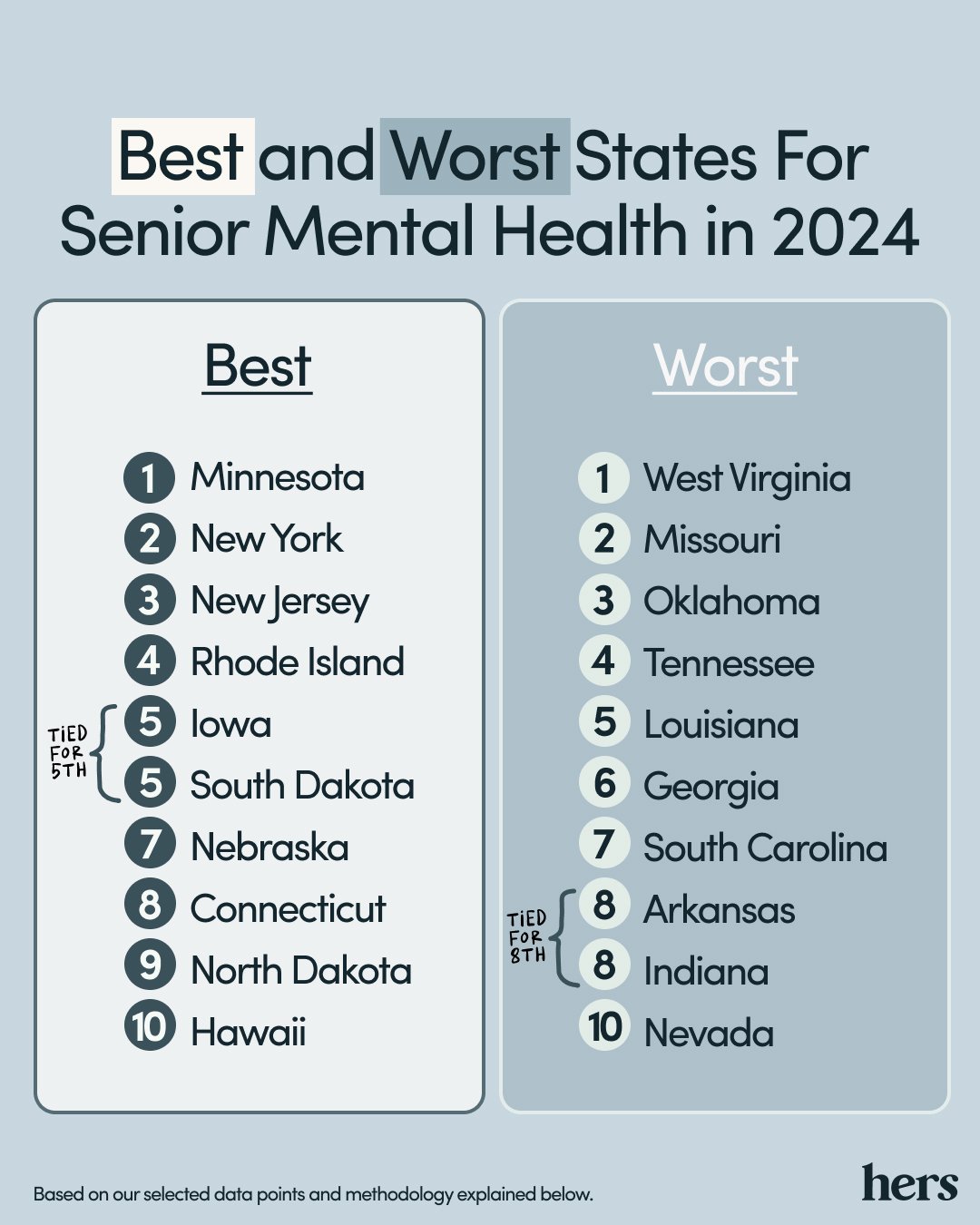Retirees are in a mental health crisis: These are the states where seniors are most at risk

njene // Shutterstock
Retirees are in a mental health crisis: These are the states where seniors are most at risk
A senior couple walking along a park path in New York City.
Every generation views their health and wellness differently.
For older Americans, mental health diagnoses are becoming more prevalent. Between 2019 and 2023, the 65+ age group collectively experienced a 57.4% increase, according to a study by FAIR Health. The number one diagnosis? Major depressive disorder.
Not only do depression and other mental health disorders lower the quality of life, they can also complicate chronic health conditions in older individuals. While it’s helpful to know that seniors are getting diagnosed more frequently than in the past, there are a number of issues that may impact outcomes—including location.
Since September is National Suicide Prevention Month, Hers looked at all 50 states to determine where seniors are getting the best mental health care and where they may be more at risk, using four data points to rank the states.
- Mental health provider ratio: Transportation and geographic location are two of the biggest barriers to mental health care access for older adults. This analysis focused on the highest concentrations of mental health providers compared to the state’s population.
- Suicide rate among seniors: Suicide rates are on the rise among seniors, particularly those who are 75 and older. This analysis looked at suicide rates for those 65+.
- Size of the senior population that frequently reports mental health as “not good”: We looked at the percentage of seniors who report 14 or more poor mental health days each month, which likely points to severe mental health issues.
- State mental health authority’s penetration rate: State mental health authorities are able to designate funding and services at the county and local levels, ideally reaching more individuals (including seniors) who have mental health needs. The penetration rate indicates how much of that population receives care.
Key Findings
- West Virginia ranks last for senior mental health care, which coincides with having the highest rate of depression in the nation across age groups.
- Minnesota and New York are the two best states for seniors and mental health. This aligns with a recent Hers study revealing New York City and Minneapolis as some of the best cities for post-pandemic mental health rebounds.
- The South dominates the list of at-risk states and includes West Virginia, Oklahoma, Tennessee, Louisiana, Georgia, South Carolina, and Arkansas.
- Four out of the 10 best states are located in the Northeast, including New York, New Jersey, Rhode Island, and Connecticut.
![]()

Hers
10 Worst States for Senior Mental Health
Hers’ list of the top 10 best and worst states for senior mental health.
1. West Virginia
2. Missouri
3. Oklahoma
4. Tennessee
5. Louisiana
6. Georgia
7. South Carolina
8. Arkansas
8. Indiana
10. Nevada
10 Best States For Senior Mental Health
1. Minnesota
2. New York
3. New Jersey
4. Rhode Island
5. Iowa
5. South Dakota
7. Nebraska
8. Connecticut
9. North Dakota
10. Hawaii
Most At-Risk States for Senior Mental Health Care: Trends and insights
Here’s a look at the best and worst states in each of the four data categories: mental health provider ratio, suicide rate for 65+ population, percentage of seniors who report 14 or more poor mental health days each month, and total penetration rate of individuals 65 and older served by the state’s mental health authority.
Which States Have the Lowest Mental Health Provider Ratio?
Limited access to mental health providers makes it harder for seniors to book appointments and actually connect with a mental health professional.
States With the Lowest Mental Health Provider Ratio
- Georgia
- Tennessee
- Alabama
States With the Highest Mental Health Provider Ratio
- Montana
- Colorado
- Nebraska
Which States Have the Highest Suicide Rates Among Seniors?
There is a stark regional difference between suicide rates. The states with the highest suicide rates have some of the nation’s lowest population densities, while those with the lowest suicide rates all have high population densities.
States With the Highest Suicide Rates Among Seniors
- Montana
- Wyoming
- Idaho
States With the Lowest Suicide Rates Among Seniors
- Massachusetts
- New York
- Rhode Island
Which States Have the Highest Amount of Seniors Experiencing Poor Mental Health Days?
This factor looks at how the percentage of seniors in each state that describe at least 14 days a month as “not good.”
States With the Highest Amount of Seniors Experiencing Poor Mental Health Days
- West Virginia
- Arkansas
- Tennessee
States With the Lowest Amount of Seniors Experiencing Poor Mental Health Days
- Hawaii
- Nebraska
- South Dakota
Which States Have the Lowest Mental Health Authority Penetration Rates for Seniors?
When states identify individuals with a mental health need, the penetration rate indicates how much of that population receives care.
States With the Lowest Mental Health Authority Penetration Rates for Seniors
- Nevada
- Illinois
- Florida
States With the Highest Mental Health Authority Penetration Rates for Seniors
- New Jersey
- New Mexico
- Iowa
Senior Mental Health Care: 50 States Ranked from Most At-Risk to Least
1. West Virginia
2. Missouri
3. Oklahoma
4. Tennessee
5. Louisiana
6. Georgia
7. South Carolina
8. Arkansas and Indiana (tied)
10. Idaho, Kansas, and Nevada (tied)
13. Wisconsin
14. New Hampshire and North Carolina (tied)
16. Kentucky and Ohio (tied)
18. Oregon and Texas (tied)
20. Alaska and Delaware (tied)
22. Arizona
23. Alabama and Mississippi (tied)
25. New Mexico
26. Florida
27. Michigan
28. Maine, Vermont, Virginia, and Washington (tied)
32. Utah
33. Montana
34. Massachusetts
35. Pennsylvania
36. Colorado
37. Wyoming
38. Maryland
39. California
40. Illinois
41. Hawaii
42. North Dakota
43. Connecticut
44. Nebraska
45. Iowa and South Dakota (tied)
47. Rhode Island
48. New Jersey
49. New York
50. Minnesota
Data & Methodology
Hers based its rankings on four data categories related to senior mental health and access to care.
- Mental health provider ratio: The number of mental health establishments in the state using data from the Census Bureau compared to the state’s population in 2023.
- Suicide rate among seniors: Using the Centers for Disease Control’s WONDER database, Hers looked at the rate of death by intentional self-harm per 100,000 people of the 65+ population.
- Size of the senior population that frequently reports mental health as “not good”: The CDC also publishes behavioral risk factors by age group. This data set includes the percentage of seniors who describe their mental health as “not good” for 14 or more days per month.
- State mental health authority’s penetration rate: This data set shows the penetration rate of seniors with an identified mental health need; the more people a state reaches through its mental health authorities, the better.
Each category was weighted equally using data at the state level.
Mental Health Resources for Seniors No Matter Where You Live
There are several resources you can access and proactive steps you can take to address your mental health needs as you get older.
- Limit social media use: Social media use has been linked to self-reported depression in adults of all ages, not just young adults and teens. Focus on social media platforms that help you connect with others in a way that brings you joy instead of mental health risks.
- Look at past trauma: There’s a reason why seniors are experiencing higher levels of mental health issues. Up to 90% of older adults have had at least one traumatic experience in their lives. Whether it’s war, loss of a spouse, or a host of other issues, the longer you’ve lived, the more exposure to potentially traumatic events you’ve had. Consider therapy treatments for PTSD to help cope in a healthy way.
- Consider therapy: No matter what cause of mental health you’re experiencing, reach out for help. Experienced mental health providers can help you find the best type of therapy for your needs. And it’s easier than ever to get help no matter where you live with the growth of virtual telehealth services.
- Explore treatment options: If you’re experiencing depression or anxiety and are interested in learning more about treatment options, there are medications for depression and anxiety that may help. Online psychiatry is a great option for people who want something more convenient than traveling to an office.
This story was produced by Hers and reviewed and distributed by Stacker Media.
